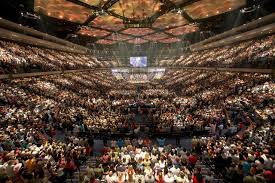Being the pastor of a large church I often hear the term “mega church” being used. Sometimes it’s used just to describe large churches, but more often than not it’s used as a derogatory term insinuating that if your church is large it must be because you’re compromising in some way – teaching sermons that satisfy what people want to hear, being seeker-sensitive, entertaining people rather than making disciples, teaching the health and wealth message – the list goes on. I should state right at the start that I love being the pastor of a large church. I love our community and the amazing things that can be achieved when lots of people are focused in the same direction. A large church can exert large influence.
The definition of a mega church is one that has 2,000 people or more in regular attendance (that’s the American definition at least). With a population of 320 million people (72% of whom identify as Christian) it should be easier to grow a mega church in the US than in Australia where our population is 13 times smaller. If we were to use the definition of a mega church proportionately, an Australian mega church should be one that is 150 people or larger! Not only is our population smaller, but so is the percentage of people that identify with the Christian faith (61%).
And that’s the point. To grow a large church in Australia is tougher and yet the church world in this nation so often compares itself to other countries and then feels inadequate as a result. It’s my opinion that we need a more Biblical approach to defining what a mega church is. “Mega” is from the Greek word “megas” which is translated a number of ways in the Bible. Depending on the context it can mean abundant, arrogant, fierce, large, loud, terrible, older, strong or severe (I’ve been to churches that fit all of these words). But most of the time megas is translated “great” – and that’s what we should all be looking for in a church community – a great church!
So what makes for a mega church? Let me suggest some things:
Firstly, Jesus referred to the great commandment, which is all about love – loving God and loving others. A mega church will focus on these things. The people will have an undeniable love for God that has been developed out of gratitude for His amazing grace. Being filled with God’s love the mega church will be good at loving others. Remember that Jesus told the story of the Good Samaritan to demonstrate what loving ones neighbour was all about. He couldn’t have used a more shocking definition if He’d tried. Jews and Samaritans hated one another. In fact Samaritans were considered half-cast Jews and were accepted by neither Jew nor Gentile. They were stuck in no-man’s land. Think of people like that today. What parable do you think Jesus would use in the 21st century to demonstrate what it means to “love your neighbour as yourself?” And so the Jewish man who was beaten, robbed and left for dead was helped by a generous Samaritan. A great (mega) church will do that.
Secondly, a mega church will demonstrate genuine community. In Acts 2 we see the first church devoting themselves “to the apostles’ teaching and to the fellowship, to the breaking of bread and to prayer.” The supernatural power of God was at work, people helped those who were in need, they met together regularly, they ate together and they grew as a result. They focused on the great commission as well as the great commandment. They made “disciples of all nations, baptising them in the name of the Father and of the Son and of the Holy Spirit, and teaching them to obey everything I (Jesus) have commanded you.” People’s lives were changed and transformed by the Gospel. Great churches still do that today.
Mega churches will encourage their people to develop genuine friendships with people outside the church community (and not just to try and convert them either). A mega church is where people are journeying together, with different age groups mixing together – the older teaching the younger and the younger respectfully encouraging the older. There will be affection for one another that is physically and practically demonstrated. People will share the experiences and milestones of life with each other – celebrating the highs and being sensitive in the lows – rejoicing with those who rejoice and weeping with those who weep. A mega church is one that will willingly and easily turn to prayer and fasting, have a high regard for God’s Word, not give clichéd answers, will tackle the hard issues of life and one that doesn’t always have to be right because we have a God who is. A mega church will also admit when it falls short of all of these things, apologise and try and do better in the future.
I used to go to church conferences where the number one question asked was “how many people do you have?” (Or, how many people are you running these days?) I used to dread the question because it assumed that just because you attracted a crowd it was in some way a sign of God’s blessing on your life – you were successful and you must be doing something right (and that may be the case). But growth and size should never be the measurement of a church’s health. A mega church is not about the number of people “attending” but rather what’s happening amongst and through those people whether they are few or many.




